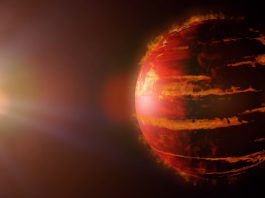For the first time, researchers have measured the mass and internal density of a very young exoplanet orbiting a newly formed, extremely active star.
Despite the ‘noise’ generated by the active star, the team, led by scientists from IRAP (CNRS/CNES/Université Toulouse III – Paul Sabatier) and IPAG (CNRS/UGA), successfully achieved this measurement of the young exoplanet using the Canada-France-Hawaii Telescope (CFHT)’s planet hunting instrument SPIRou.
According to a paper published in MNRAS, the star, named AU Microscopii (AU Mic), is no more than 22 million years old, which is more than four billion years younger than our Sun. AU Mic is home to a gas giant named AU Mic b, the mass and density of which has now been determined using the SPIRou spectropolarimeter.
The team discovered that AU Mic b’s properties are very similar to those of Neptune, however, the exoplanet’s orbit is 450 times nearer its star than Neptune is to the Sun. Its atmosphere has a temperature of 300°C, and it therefore belongs to the family of ‘hot Neptunes’.
Due to AU Mic’s high activity, the star generates very strong magnetic fields, making it extremely difficult to analyse the AU Mic b signal. However, SPIRou’s high-performance capabilities, together with the work carried out by the scientists from IRAP and IPAG1, finally made it possible to determine its mass and density, despite the ‘noise’ generated by AU Mic’s activity.
This is the first exoplanet whose mass has been measured by SPIRou, a next-generation instrument designed and built under the supervision of French teams and recently mounted on the Canada-France-Hawaii Telescope (CFHT). In three other recently published papers, the research teams involved with SPIRou have also confirmed the unrivalled performance of the new instrument, and studied another characteristic of AU Mic b, the inclination of its orbit, which is aligned with the equatorial plane of its star, suggesting that its formation was not affected by other massive objects.









